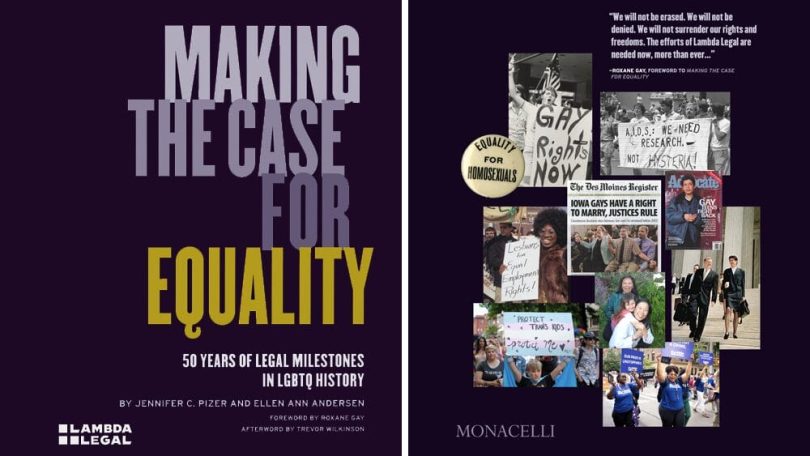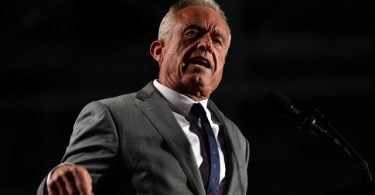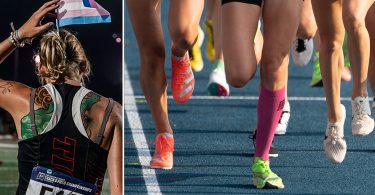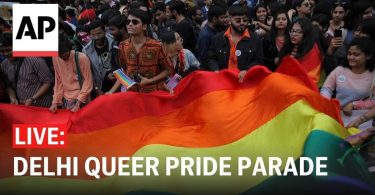As LGBTQ rights and liberties flourish and encunter major hurdles, Lambda Legal and the nonprofit legal organization’s most senior attorney Jennifer C. Pizer and historian Ellen Ann Andersen have penned “Making the Case for Equality: 50 Years of Legal Milestones in LGBTQ+ History”.
The coffee table book opens Lambda Legal’s archive, celebrating half a century of advocacy. With a foreword by best-selling author Roxane Gay, the book highlights legal cases with rich illustrated and historic photos as well as details of dozens of landmark legal cases that have expanded civil rights for LGBTQ people in education, employment, marriage, healthcare, housing, and military service.

Cases include Doe v. SEPTA (1994) which strengthened privacy protections for individuals living with HIV/AIDS which establishing important precedent for medical confidentiality and Obergefell v. Hodges (2015) which legalized same-sex marriage across the U.S.
It also dives into cases like Lawrence v. Texas (2003) which decriminalized private consensual same-sex activity nationwide, overturning state sodomy laws as well as Zarda v. Altitude Express (2020) which established that workplace discrimination based on sexual orientation or gender identity is prohibited under Title VII of the Civil Rights Act.
“This book is a testament to the relentless pursuit of equality and justice for all people, regardless of gender or sexual orientation,” said Pizer. “It serves as a reminder that while we’ve come far, the work is far from over.”
GLAAD had the opportunity to interview co-author Pizer about the book, how its being released so close to the election, and how it is preserving LGBTQ history.
How did the idea for creating a tangible record of legal cases come from? And how long has this been in the works?
This book celebrates Lambda Legal’s fiftieth anniversary and was the brainchild of Lambda Legal CEO Kevin Jennings and Keith Fox, CEO of Phaidon Press, the world’s leading publisher of beautiful coffee table books. Keith has been a fan of Legal’s work for many years. He and Kevin came up with the idea of this book to do multiple things. First, to be a gorgeous showcase for nonlawyers and lawyers alike to observe how Lambda Legal’s impact litigation and other advocacy has driven transformative progress for our community. Lambda Legal’s role is barely known, even by many members of our own community. As we’ve told our history during this anniversary year, we’ve heard again and again: “I didn’t know Lambda Legal did that case!” Or, “You all came up with that strategy? I had no idea!” They envisioned this book as a perfect way to tell more of our story in a compelling, accessible way.
Also, this book filled with photos and archival material is a unique way to tell how a tiny group of lawyers in New York City just after Stonewall grew into a nationwide team tackling discrimination problems touching every area of our lives. The concept was to include dozens of stories with hundreds of images to give all sorts of readers an immersive introduction to the world of LGBTQ+ civil rights advocacy. There’s plenty of books about law that are mostly words; and many about our movement with photos but not insider perspectives about what was going on, how the work was done, and how the impact fit into the bigger picture. This book has quotes from the legal strategists about the challenges they faced, from the courageous plaintiffs about their hopes and how it felt, and graphics to show how the work advanced over time. It’s filled with reflections from the people involved, together with historical context for all readers.
The journey from inspired idea to books-on-sale has taken just under three years, and the narrative stretches from Lambda Legal’s first case, for the right to exist as a nonprofit under New York law dedicated to providing legal services to “homosexuals,” to today’s headlines about school book bans, the targeting of transgender young people, and calls for Supreme Court reform.

We are coming upon an election and this book is the perfect source. Was the timing on this intentional?
The book’s publication was timed to mark the close of our 50th Anniversary year, and it’s just a great coincidence that it is coming out just as we go to the polls for an extraordinarily important election in which many of our basic civil rights are at stake. If the book motivates more people to get out and vote, that will be terrific. Honestly, though, we have been thinking more about how the hundreds of anti-LGBTQ+ bills introduced in state legislatures in recent years have caused panic, despair, and feelings of powerlessness for many in our community. Especially for younger people, we hope this book is reassuring and encouraging by showing how much we’ve accomplished against different but still-overwhelming odds in the past. As ever, our opponents have vastly more resources than we do and they are intensely focused these days on making it excruciatingly difficult for trans and nonbinary young people to live openly as their authentic selves. We hope many readers of this book will be inspired by our track record of success to see that we know how to fight back, and decide to get involved in whatever ways work for them.
What are some of the most interesting cases in the book that stood out to you?
Since I had the privilege of doing most of the case selection, the book only includes cases that I have found interesting and important in some way. That said, some cases do stand out because they changed the law and public understanding in a huge way nationwide. One example is Nabozny v. Podlesny, in which we represented Jamie Nabozny against his former public school because the school authorities blamed him for being violently bullied by his classmates! They said Jamie had to expect attacks because “boys will be boys” and he was “acting gay.” Our litigation put a nearly $1 million price tag on that official acquiescence in anti-LGBTQ+ abuse, which sent a wake-up call to school administrators coast-to-coast.
I also hope readers will be excited to see how we put together marriage equality cases to educate judges and the public about why marriage matters to same-sex couples for the same range of reasons the institution has been important to different-sex couples through the years. The selection of family law cases in the chapter before the marriage chapter prepares readers for the roadmap through the marriage litigation by showing how we had to try to protect family relationships using piecemeal arguments, which only worked sometimes, during the years the full protections of marriage were out of reach. Many older readers will remember or have lived through those times. But younger readers might not realize what we had to do – and how imperfect those scant legal protections were. Knowing our history can reinforce the stakes for protecting our victories during these times of reactionary attacks.
We also hope lawyers and non-lawyers alike will be intrigued to see that sometimes there’s a relationship between a court case and advocacy to pass a law to prevent the particular type of problem in the first place. The book includes multiple heartbreaking examples of the sudden death of one domestic partner, which left the surviving partner to realize, suddenly, that they were not legally recognized for victim compensation, to make burial decisions, or as a parent to the couple’s child. Such tragic cases inspired repeated improvement of California’s laws protecting registered domestic partners and, in doing so, set the stage for winning the freedom to marry in that state. Those synergies usually aren’t obvious publicly, and we hope readers will be fascinated and want to know more about the less public aspects of our strategic advocacy.

While working on this book, what surprised you the most?
I didn’t expect it to be so much fun and absorbing to use so many photos and other visual material to present our legal cases, and to include quotes from our clients, our lawyers, and sometimes judges, too, to bring readers into the feel of the story. I know that people take in information in different ways. But I haven’t had the opportunity to use infographics and artistic design as we’ve done in the book to bring the information to life visually. I think this book is truly unique in offering so much information in a way that’s easy to browse and immerse in this way. It really was fun to explore ways of doing this, and very satisfying.
It also was fun and satisfying to show readers how public education is an integral part of our impact advocacy. And to show how much we are doing to improve public systems – such as foster care, prisons, and our judicial system. Disproportionate numbers of LGBTQ+ people are living in these systems (whether they want to or not), and often experience callous bigotry, largely out of public view and with limited recourse. I’m proud of our work in these areas and was challenged and then gratified by how we came up with to make it visible and engaging.
Many members of the LGBTQ community will want to have a copy of this book, but ideally, who would you want to have this book?
We especially hope it will be in school libraries, included in class reading lists, and otherwise available to anyone who is feeling isolated or scared by anti-LGBTQ+ bullying or other kinds of bigotry. We believe this book will lift them up and make them feel proud and connected to our large, welcoming movement–and then inspired to get involved. What we have accomplished from the days when same-sex relationships were criminalized in most of the country to thousands upon thousands of LGBTQ+ student clubs and the freedom to marry nationwide–it’s astonishing. And while there is so much more work ahead of us, especially given the current, intensified political attacks, the dozens of landmark victories presented in this book are a gorgeously illustrated history of our community’s courage, the skill and strategic savvy of Lambda Legal’s team, and our steadily building success over these decades.
How does “Making the Case for Equality” speak to where you are at in your career and life right now?
My affiliation with Lambda Legal, and the start of my immersion in this area of work, began as a student intern when I was at NYU School of Law in the mid-80s. Over these four decades, I have been a volunteer, a Board member, and then, after a while in private practice, on staff for many years. So I have had a front-row seat, and sometimes a driver’s seat, as we have challenged so many types of bias, invisibility, discrimination, and loss, and made great progress. Now, as the leader of our Legal Department, I draw constantly on the lessons of our thousands of past cases, legislative proposals, persuasion campaigns, victories and set-backs.
Legal advocacy so often builds from one precedent to the next, with each success creating new foundation for future efforts. Knowledge is power, and knowing our history is both empowering and pragmatically useful. Writing “Making the Case for Equality” was a trip down Memory Lane, a chance to sift through photos and files and relive extraordinary moments with past clients, to grieve again the loss of beloved former colleagues, and to appreciate the brilliance and unexpectedly synergistic partnership created among my co-author, Professor Ellen Andersen, our photo editor, Michael Green, and our Senior Paralegal, Jamie Farnsworth. Together with the talented team at Phaidon Press, we’ve created a record of this time period that’s widely relatable. It’s also personal. I left my private law firm practice 28 years ago. And thanks to work detailed in the book – much of which I’ve had the privilege of participating in – my wife and I celebrated our 16th wedding anniversary in early October, one week before we toasted the 40th anniversary of when we started our relationship. As they say, the personal is political … and also legal and historical!
Purchase a copy of “Making the Case for Equality” here.







